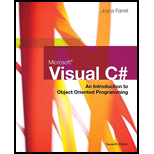
In Chapter 9, you created a Contestant class for the Greenville Idol competition. The class includes a contestant’s name, talent code, and talent description. The competition has become so popular that separate contests with differing entry fees have been established for children, teenagers, and adults. Modify the Contestant class to contain a field that holds the entry fee for each category, and add get and set accessors.
Extend the Contestant class to create three subclasses: ChildContestant, TeenContestant, and AdultContestant. Child contestants are 12 years old and younger, and their entry fee is $15. Teen contestants are between 13 and 17 years old, inclusive, and their entry fee is S20. Adult contestants are 18 years old and older, and their entry fee is $30. In each subclass, set the entry fee field to the correct value, and override the Tostring() method to return a string that includes all the contestant data, including the age category and the entry fee.
Modify the GreenvilleRevenue
• The program prompts the user for the number of contestants in this year’s competition, which must be between 0 and 30. The program continues to prompt the user until a valid value is entered.
• The program prompts the user for names, ages, and talent codes for the contestants entered. Along with the prompt for a talent code, display a list of valid categories. Based on the age entered for each contestant, create an object of the correct type (adult, teen, or child), and store it in an array of Contestant objects.
• After data entry is complete, display the total expected revenue, which is the sum of the entry fees for the contestants.
• After data entry is complete, display the valid talent categories and then continuously prompt the user for talent codes, and display all the data for all the contestants in each category. Display an appropriate message if the entered code is not a character or a valid code.
Trending nowThis is a popular solution!

Chapter 10 Solutions
Microsoft Visual C#
- Please solve and answer the questions correctly please. Thank you!!arrow_forwardConsidering the TM example of binary sum ( see attached)do the step-by-step of execution for the binary numbers 1101 and 11. Feel free to use the Formal Language Editor Tool to execute it; Write it down the current state of the tape (including the head position) and indicate the current state of the TM at each step.arrow_forwardI need help on inculding additonal code where I can can do the opposite code of MatLab, where the function of t that I enter becomes the result of F(t), in other words, turning the time-domain f(t) into the frequency-domain function F(s):arrow_forward
 Microsoft Visual C#Computer ScienceISBN:9781337102100Author:Joyce, Farrell.Publisher:Cengage Learning,Programming Logic & Design ComprehensiveComputer ScienceISBN:9781337669405Author:FARRELLPublisher:Cengage
Microsoft Visual C#Computer ScienceISBN:9781337102100Author:Joyce, Farrell.Publisher:Cengage Learning,Programming Logic & Design ComprehensiveComputer ScienceISBN:9781337669405Author:FARRELLPublisher:Cengage EBK JAVA PROGRAMMINGComputer ScienceISBN:9781337671385Author:FARRELLPublisher:CENGAGE LEARNING - CONSIGNMENT
EBK JAVA PROGRAMMINGComputer ScienceISBN:9781337671385Author:FARRELLPublisher:CENGAGE LEARNING - CONSIGNMENT Programming with Microsoft Visual Basic 2017Computer ScienceISBN:9781337102124Author:Diane ZakPublisher:Cengage Learning
Programming with Microsoft Visual Basic 2017Computer ScienceISBN:9781337102124Author:Diane ZakPublisher:Cengage Learning EBK JAVA PROGRAMMINGComputer ScienceISBN:9781305480537Author:FARRELLPublisher:CENGAGE LEARNING - CONSIGNMENT
EBK JAVA PROGRAMMINGComputer ScienceISBN:9781305480537Author:FARRELLPublisher:CENGAGE LEARNING - CONSIGNMENT C++ Programming: From Problem Analysis to Program...Computer ScienceISBN:9781337102087Author:D. S. MalikPublisher:Cengage Learning
C++ Programming: From Problem Analysis to Program...Computer ScienceISBN:9781337102087Author:D. S. MalikPublisher:Cengage Learning





